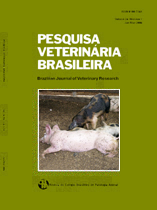 |
|
|
|
Year 2012 - Volume 32, Number 11
|

|
Epidemiological, clinicopathological and immunohistochemical aspects of vulval squamous cell carcinomas in 33 cows, 32(11):1127-1132
|
ABSTRACT.- Rosa F.B., Kommers G.D., Lucena R.B., Galiza G.J.N., Tochetto C., Silva T.M. & Silveira I.P. 2012. [Epidemiological, clinicopathological and immunohistochemical aspects of vulval squamous cell carcinomas in 33 cows.] Aspectos epidemiológicos, clinicopatológicos e imuno-histoquímicos de carcinomas de células escamosas vulvares em 33 vacas. Pesquisa Veterinária Brasileira 32(11):1127-1132. Laboratório de Patologia Veterinária, Departamento de Patologia, Universidade Federal de Santa Maria, Camobi, Santa Maria, RS 97105-900, Brazil. E-mail: glaukommers@yahoo.com
Vulvar squamous cell carcinomas (VSCCs) in cattle were retrospectively studied regarding the prevalence, epidemiology, clinicopathological, and immunohistochemical aspects. The degree of vulvar pigmentation was also evaluated. In the 48 years analyzed, necropsy and biopsy reports of 7,483 cattle were found. Out of these, 664 (8.87%) cases of various neoplasms were identified; 33 (4.97%) of these cases were of VSCCs. Nineteen cows were Holstein, three were Charolais, one was Jersey, and 10 were mix breed cows. Grossly, the main change was vulvar swelling, with bleeding and concomitant myiasis. The tumor masses were firm, ulcerated and with yellow areas. It was possible to reevaluate microscopically 30 out of the 33 cases. Eight of them were well differentiated, 17 were moderately differentiated, and five were poorly differentiated VSCCs. The evaluation of squamous intraepithelial lesions (SILs) was performed in 21 cases. Epithelial hyperplasia was observed in 10 cases, mild dysplasia in two, moderate in one, and severe in five cases; in three cases no SILs were observed. Fontana-Masson stain for melanin was performed in 21 cases. In 17 cases the epidermal pigmentation was absent; it was mild in two and moderate in other two cases. Independently of the degree of differentiation, most neoplastic keratinocytes were strongly positive for bovine pancytokeratine through the immunohistochemistry (IHC) technique. Bovine papillomavirus was not detected by IHC in this study. |
| |
|
|
| |
|
 |